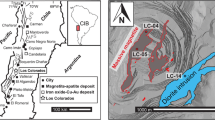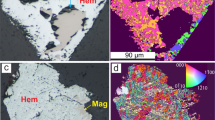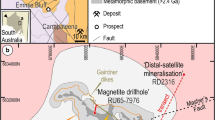Abstract
The iron-oxide system can be used as a marker of oxidized and reduced conditions in closed systems. However, natural rocks with iron oxide minerals also exhibit such reactions, although the natural system is typically open. To understand the behaviour of this natural system, some similarities were investigated, in terms of crystallographic textures, between the microstructures of two systems: natural open system and synthetic closed system of iron oxide phase transformation. Particular cases of phase transformation in iron oxide minerals, described as natural reactions of magnetite to hematite and synthetic reactions of hematite to magnetite, were chosen. It is observed, in both scenarios, that the transformation obeys the topotaxial and epitaxial relationship, which are well described for the iron oxide system. However, in natural open systems, the precipitation of a new phase during the in situ transformation modifies the microstructures and must be taken into account as an important factor to describe them.





Similar content being viewed by others
References
Adam F, Dupre B, Gleitzer C (1989) Cracking of hematite crystals during their low-temperature reduction into magnetite. Solid State Ionics 32(33):330–333
Barbosa PF, Lagoeiro L (2010) Crystallographic texture of the magnetite-hematite transformation: evidence for topotactic relationships in natural samples from Quadrilatero Ferrifero, Brazil. Am Mineral 95:118–125. doi:10.2138/am.2010.3201
Becker PP, Heizmann JJ, Baro R (1977) Relations Topotaxiques entre des Cristaux Naturels D'Hématite et la Magnétite qui en est Issue par Réduction à Basse Température. J Appl Cryst 10:77–78
Blake RL, Hessevick RE, Finger LW (1966) Refinement of the hematite structure. Am Mineral 51:123–129
Doherty RD, Hutchings KM, Smith JD, Yörük S (1985) The reduction of hematite to wustite in a laboratory fluidized Bed. Metall Mater Trans B 10B:425–432. doi:10.1007/BF02654840
Dorr JVN II (1969) Physiographic, stratigraphic and structural development of the Quadrilátero Ferrífero, Minas Gerais, Brazil. USGS prof. paper. Washington 641:A1–A103
Fabrichnaya O, Sundman B (1997) The assessment of thermodynamic parameters in the Fe-O and Fe-Si-O systems. Geochim Cosmochin Ac 61(21):4539–4555
Fleet ME (1981) The structure of magnetite. Acta Crystallogr 37:917–920
Floran RJ, Papike JJ (1978) Mineralogy and petrology of the Gunflint ironformation, Minnesota-Ontario: Correlation of compositional and assemblage variations at low to moderate grade. J Petrol 19:215–288
Heizmann JJ, Becker P, Baro R (1981) The influence of crystallite orientations on the chemical reactivity of hematite A-Fe2O3 and magnetite Fe3O4. J Appl Cryst 14:270–273
Lagoeiro LE (1998) Transformation of magnetite to hematite and its influence on the dissolution of iron oxide minerals. J Metamorph Geol 16:415–423
Leep H (1957) Stages in the oxidation of magnetite. Am Mineral 42:679–681
Morris RC (1980) A textural and mineralogical study of the relationship of iron ore to banded iron-formation in the Hamersley iron province of Western Australia. Econ Geol 75:184–209
Mücke A (2003) General and comparative considerations of whole-rock and mineral compositions of Precambrian iron-formations and their implications. Neues Jb Miner 179:175–219
Mücke A, Annor A (1993) Examples and genetic significance of the formation of iron oxides in the Nigerian banded iron-formations. Miner Deposita 28:136–145
Mücke A, Cabral AR (2005) Redox and nonredox reactions of magnetite and hematite in rocks. Chemie Erde 65:271–278
Ohmoto H (2002) Nonredox transformations of magnetite-hematite in hydrothermal systems. Econ Geol 98:157–161. doi:10.2113/gsecongeo.98.1.157
Otake T, Wesolowski DJ, Anovitz LM, Allard LF, Ohmoto H (2007) Experimental evidence for non-redox transformations between magnetite and hematite under H2-rich hydrothermal conditions. Earth Planet Sc Lett 257:60–70
Phillips B, Muan A (1960) Stability relations of iron oxides: phase equilibria in the system Fe3O4-Fe2O3 at oxygen pressures up to 45 atmospheres. Stability Relations of Iron Oxides 64:1451–1453
Piotrowski K, Mondal K, Lorethova H, Sonawski L, Szymanski T, Wiltowski T (2005) Effect of gas composition on the kinetics of iron oxide reduction in a hydrogen production process. Int J Hydrogen Energ 30:1543–1554. doi:10.1016/j.ijhydene.2004.10.013
Rosière CA, Siemes H, Quade H, Brokmeier HG, Jansen EM (2001) Microstructures, textures and deformation mechanisms in hematite. J Struct Geol 23:1429–1440
Sastri MVC, Viswanath RP, Viswanathan B (1982) Studies on the reduction of iron oxide with hydrogen. Int J Hydrogen Energy 7(12):951–955
Schobbenhaus C, Kaul PFT (1971) Contribuição à estratigrafia da Chapada Diamantina, Bahia Central. Mineração e Metalurgia 53(315):116–120
Swaddle TW, Oltmann P (1980) Kinetics of the magnetite-maghemite-hematite transformation, with special reference to hydrothermal systems. Can J Chem 17(58):1763–1772. doi:10.1139/v80-279
Turkdogan ET, Vinters JV (1971) Gaseous reduction of iron oxides: part I. Reduction of hematite in hydrogen. Metall Trans 2:3175–3188
Wiltowski T, Piotrowski K, Lorethova H, Stonawski L, Mondal K, Lalvani SB (2005) Neural network approximation of iron oxide reduction process. Chem Eng Process 44:775–783. doi:10.1016/j.cep.2004.08.007
Acknowledgments
The authors would like to acknowledge the Center of Microscopy at the Universidade Federal de Minas Gerais (http://www.microscopia.ufmg.br) and MICROLAB at the Universidade Federal de Ouro Preto for providing the equipment and technical support for experiments involving electron microscopy. We are grateful to Jamie Beaulieu by the technical support in the Rock Mechanics Laboratory at Brown University and Breno Barbosa for his technical assistance in Center of Microscopy.
Author information
Authors and Affiliations
Corresponding author
Additional information
Editorial handling: F. Dong
Rights and permissions
About this article
Cite this article
Barbosa, P.F., Lagoeiro, L., Scholz, R. et al. Magnetite-hematite transformation: correlation between natural and synthetic features. Miner Petrol 109, 329–337 (2015). https://doi.org/10.1007/s00710-014-0340-8
Received:
Accepted:
Published:
Issue Date:
DOI: https://doi.org/10.1007/s00710-014-0340-8




